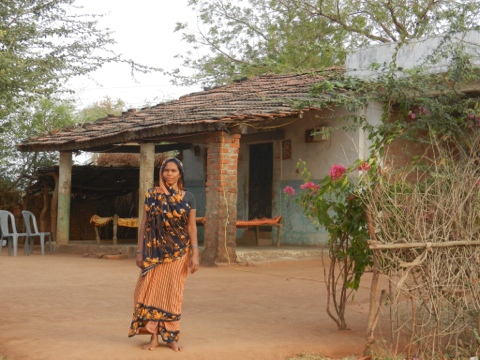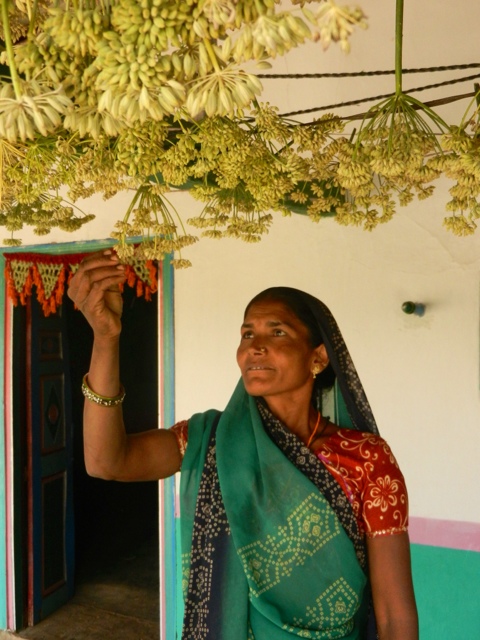
One of the most unforgettable memories of my childhood, was watching Bimal Roy’s classic movie, Do Bigha Zamin . The tragic story of Balraj Sahni and Nirupa Roy, and their unsuccessful efforts to retain their small piece of land, became etched in my mind as the fate of the Indian farmer, struggling against all odds.
So when I visited the Adivasi hamlets of Navagraha and Guyvaachada in the Meghraj block of Sabarkantha district in North Gujarat, sub consciously I feared I would see a similar picture of sadness and despair. Without access to irrigation, these village hamlets are Rain-fed and therefore much poorer than the villages I had visited in Mehsana. The soil is rocky, and land holdings which have been fragmented over time, measure no more than 1 or 2 Bighas at most ( 1 Bigha is 1/3 of an acre).
Fortunately, even though the lives of villagers in these hamlets remains extremely tough, the grinding poverty of the past seems to have been eliminated, thanks in large part to watershed works.
Funded by Nabard under a Central Government scheme, Watershed work was started in 11 villages in the Sabarkantha district in 1999. The scheme was structured so as to involve local communities, and the contribution of Villagers was in the form of Shramdaan (the gift of self labour). Most watershed structures were constructed from mud so as to demonstrate to the villagers that these were effective and that they could be locally constructed and repaired when necessary without expensive materials.
The watershed work proved effective, and Water started getting recharged in wells and tube wells, to the extent that there was sufficient water for at least one crop in the Rabi season.
In 2005, the Nabard scheme was withdrawn. In 2007, the RBS Foundation was approached by DSC (founded by the late Anilbhai Shah), to support a Livelihood Enhancement Program through
Natural Resource Management (LEP NRM) in the same 11 villages, so as to ensure that the progress achieved was consolidated and enhanced through further capacity building and market linkages.
The Adivasi villages of Meghraj are beautiful and picturesque. Though the homes are simple mud structures and the full extent of land fragmentation is clearly visible, each house is aesthetically decorated with natural paints and colors. The small Aangans (courtyards) are filled with flowering plants and the surroundings are fragrant and clean. There is a sense of great peace and tranquility about these villages.
The structure of these villages is noticeably different from the villages that I saw in both Kutcch and Mehsaana. Instead of being clustered together, homes here are located alongside the land holding of the owner. Thus the village of Navagraha with 253 houses and a population of approx 1500 people, is very spread out and as a consequence consists of several hamlets, comprising 30 – 40 households each. As sons come of age and marry, they leave their parents’ home, and build a small mud hut on the portion of land allotted to them.
Somewhat to my surprise, each home had an electric connection (power was generally available for 8 hours a day) and mobile connectivity (including 2G ) was reasonably good. However no home that I visited in Navagraha or Guyvaachada either had either a water connection, or a toilet.
For my stay in this area, our field staff had therefore, placed me in the home of Jaya Ben and Babu Bhai, located 5 minutes away from the village primary school, where there was a small toilet.
The story of Babu Bhai and Jaya Ben, my hosts, was thankfully a much happier one than that of Balraj Sahni and Nirupa Roy ! Though they also owned only Do Bigha Zamin, ( 2/3 of an acre) the watershed work of the past years had replenished the well on their land. For the last few years the Rabi wheat crop had provided sufficient Grain to feed their family of five.
Through the RBS LEP NRM project, agricultural assistance had been provided to the farmers in Meghraj block, to plant organically grown and pesticide free spices like Adrak (Ginger), Haldi (Turmeric) and Saunf (Anise). As part of the program, women of the village were assisted to form a Self Help Group (SHG) called Sangam, to clean, sort, grade, and pack the spices. They also set up a vermicompost pit, to supply organic fertiliser to the village farms.
The Sangam SHG is today a registered cooperative society of 650 women in the Sabarkantha area. Started in 2008 with a focus on providing women with a means of small savings, the accumulated savings of the group today exceeds Rs 650,000. Loans of up to Rs 15000 are granted once Rs 3000 has been saved. In 2009, it was registered as a Federation, and the SHG moved to stage 2 with a focus on income generation through vermicompost ; and packing, grading, sorting, and selling of spices. And in 2011 it was registered as a Cooperative Society.
Many of the women of Navagraha had been beneficiaries of the MG NREGA scheme in its early years – undertaking hard labour for road construction etc. As they shared their journey, one said to me in Gujarati : “Without Sangam our only alternative was hard manual labour. Now we have the confidence to stand on our own feet !”
Jaya became an early and enthusiastic member of the Sangam SHG, and her income from these activities became a useful second source of income for the household.
Through the incremental income so generated Babu bhai and Jaya ben were able ( like several other villagers ) to buy a cow and a few goats, which became a third source of income.
Though they are still a family that is categorised as living Below the Poverty Line (BPL) Babu bhai and Jaya ben were very gracious and hospitable hosts. I spent a wonderful night sleeping in their courtyard, under the stars, and very much enjoyed listening to the story of their life and interacting with their 3 young sons : Jitendra in class XII, Mayank in class VII ( who broke me a fresh neem Datun from the neem tree at dawn !) and Dharmik in class VII.
We discussed cropping patterns in detail. Like other farmers in the area, Babu Bhai was now exploring planting cotton, as he had heard that other farmers had received a good price last year. As we spoke with other farmers in the Navagraha watershed committee, it was clear that more and more of them were considering moving to cash crops notwithstanding the fact that cultivating crops like cotton was very water intensive.
In passing, I saw a basket filled with Moong Dal (a staple lentil). On asking, it emerged that Moong grew extremely well in this area with little effort – and also with little need for water. It could also be grown as both a Rabi (winter) and Kharif (summer) crop. And so we had a really interesting conversation, where we sat and calculated what the return on investment would be if Babu Bhai planted Moong instead of cotton. It soon became clear that given current prices of Dal, and projections of continued shortfall in domestic production, planting Moong instead of cotton could be a much better idea !
Though until this point he had regarded Moong as a crop only to be cultivated only for personal consumption, I was impressed with the swiftness with which Babu Bhai grasped the calculations, and his follow up with our field staff to establish market linkages should he chose to plant Moong for the Kharif season. The interaction taught me a powerful lesson : Our farmers don’t need protection – all they need is access to accurate market information, and to efficient and fair markets, and they will not only thrive but also ensure the food security of our country.
This point was reinforced when I met Babli Ben, a very hard working widow from the neighbouring hamlet of Guyvaachada. She had an even smaller land holding of only 1 Bigha. Perennially dry, the land had lain fallow for many years.
However post the watershed works, she had started to observe water levels rising in the wells around the village. So she took her courage in her hands and sought a loan of Rs 20,000 from the Sangam SHG, to sink a bore well. Fortunately she struck water, and was able to plant Saunf for the Rabi season. As she proudly showed me her harvest, she confided that it would sell for more than Rs 10,000 allowing her to repay half her loan in the first year itself !
Encouraged by the tremendous self reliance and hard work of villagers like Babu Bhai, Jaya Ben and Babli Ben, the RBS Foundation has extended our support till 2015 and brought a further 7 villages of Sabarkantha under the purview of the project.
As in the case of Mehsana, the road to prosperity in the hamlets of Sabarkantha, has begun with that most precious of all commodities – water; but it is being cemented by the hard work and entrepreneurship of simple villagers like Babli Ben, Babu Bhai and Jaya Ben, whose stories fill one with both happiness and hope.

http://meerasanyal.wordpress.com/2012/04/06/hamlets-of-meghraj/
No comments:
Post a Comment